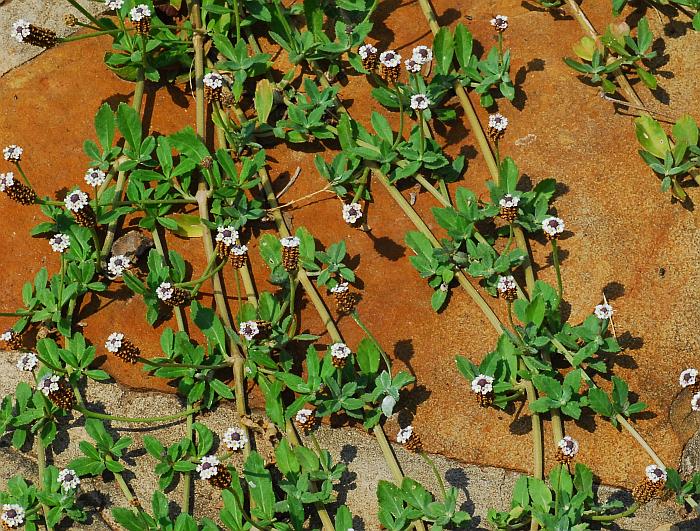Lippia nodiflora (L.) Michx.
Common Fog Fruit

Native
CC = 10
CW = -3
MOC = 1
© SRTurner
Lippia nodiflora (L.) Michx.Common Fog Fruit | |
 |
Native CC = 10 CW = -3 MOC = 1 |
© SRTurner |
|
Family - Verbenaceae Habit - Perennial forb from a nonrhizomatous, only slightly woody rootstock. Stem - Prostrate, to 60 cm, few to several from rootstock, often rooting at nodes, sparsely to moderately hairy with sessile dolabriform hairs.
Leaves - Opposite, simple, sessile or nearly so, 1-5 cm long, narrowly oblanceolate to narrowly elliptic-oblanceolate, mostly broadest above the midpoint, rounded or angled to a bluntly pointed tip, the margins with 3-7, broad, sharp teeth on each side from above the midpoint to the tip, the surfaces moderately to densely hairy.
Inflorescences - Dense, spherical to oblong, axillary heads, 5-8 mm in diameter, to 2.5 cm long, solitary at the tips of slender, erect, naked stalks to 10 cm long. Bracts 2-3 mm long, obovate, sometimes with purplish tinged margins.
Florets - Calyces 1.5-2.0 mm long, about as long as the corolla tube, bilobate, keeled, the surface glabrous or nearly so, but with a line of hairs along the keels. Corollas 3-4 mm long, zygomorphic, somewhat 2-lipped, 4-lobed, white, usually with a yellow or pink central spot at the base of the limb, the limb 2-4 mm in diameter, the lobes slightly irregular or shallowly and broadly notched. Stamens inserted at 2 levels toward the tip of the corolla tube, lacking glandular appendages. Ovary 2-locular (1 of the carpels aborting early in development), rounded at the tip. Style 0.2-0.4 mm long, the minute lobes spreading, but obscured by the confluent stigmatic regions, these appearing as a single capitate stigma.
Fruits - Schizocarps, appearing somewhat flattened longitudinally, circular to broadly obovate in outline, consisting of 2 nutlets, these 1.0-1.3 mm long, more or less hemispheric, usually rounded at the tip and base, the surface finely pebbled or minutely pitted, olive green to yellowish brown. Flowering - May - September. Habitat - Moist, disturbed areas. Origin - Native to the U.S. Lookalikes - L. lanceolata. Other info. - This little species is rare in Missouri, known in the state from only a single collection in 1892. It is far more common to our south, and in fact the distribution within the continental U.S. is largely confined to about the southern third of the country. It is distinguished from Missouri's other, much more common fog fruit (L. lanceolata) by its leaves, which are usually widest above the midpoint and toothed only above the midpoint. The taxononmy of the genus is somewhat unsettled, with some authors placing the Missouri species into the genus Phyla. Numerous infraspecific forms have also been recognized. Missouri plants would be referrable to var. nodiflora. Photographs taken at Tishomingo National Wildlife Area, Johnston County, OK, 7-27-2016 (SRTurner). |